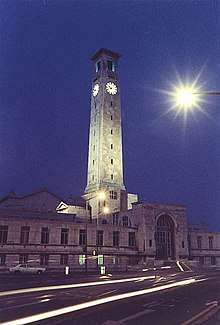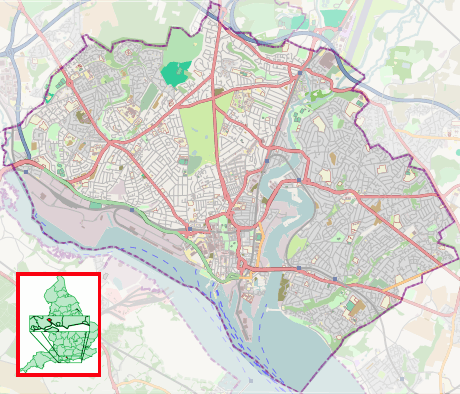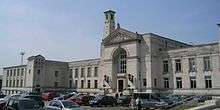Southampton Civic Centre
The Civic Centre is a municipal building located in the Cultural Quarter area within the city of Southampton. It comprises offices occupied by Southampton City Council, the SeaCity Museum, the Guildhall, the Southampton City Art Gallery, and the city library. It was designed by the English architect Ernest Berry Webber in the Classical style in 1929 and constructed over a ten year period. It was completed in 1939. Pevsner's Hampshire: South describes it as "the most ambitious civic building erected in the provinces in the interwar years".[1] It was listed as a Grade II* listed building in 1980.[2]
| Southampton Civic Centre | |
|---|---|
 Southampton Civic Centre | |
| Location | Southampton |
| Coordinates | 50°54′28.78″N 1°24′23.46″W |
| Built | 1932 |
| Architect | Ernest Berry Webber |
| Architectural style(s) | Classical style |
Listed Building – Grade II* | |
| Designated | 10 October 1980 |
| Reference no. | 1092036 |
 Location in Southampton | |
History
Early history
Since the 1870s, there was debate in the council over the housing of the borough offices: departments were scattered around the town, making co-ordination and timely response fairly difficult, with the old Audit House opposite Holyrood Church being totally inadequate.[3] After extensive discussions about the proposed civic centre, Herbert Austin-Hall was appointed to assess a design competition for the new building.[4] Following the competition, Ernest Berry Webber was chosen to design the centre in the Classical style with a budget of just under £400,000.[4] The foundation stone was laid by the Duke of York on 1 July 1930.[4]
The first block to be opened, known as the south wing, contained the municipal offices. Some of the material dug out during the construction of the south wing was used to fill in an old reservoir on Southampton Common as part of the process of converting it into a paddling pool.[5] It was opened by the Duke of York, and his wife, the Duchess of York, on 8 November 1932.[4]
The second block, known as the west wing, contained the law courts and the police headquarters. It also contained "Kimber's Tower", which is 157 feet (48 m) high[6] and named after Sir Sidney Kimber, who had chaired the civic centre development committee.[4] The block was opened by Viscount Sankey, the Lord Chancellor, on 3 November 1933.[4] It was decided that during the opening ceremony and every four hours thereafter the bells should sound the Westminster Quarters followed by the first verse of the hymn Our God, Our Help in Ages Past.[4]
The third block, known as the east wing, contained Southampton Guildhall. Work on the Guildhall (the east wing) began in March 1934. The Guildhall was intended as a social location for municipal functions. The Guildhall was opened by Earl of Derby on 13 February 1937.[7]
The fourth block, known as the north wing, contained Southampton City Art Gallery and Southampton Central Library. This began later than the others, and late alterations to the designs were required to incorporate a public library, that was not originally planned for. The expansion of this wing led to an increase in costs for the project, but the budget increase was approved by Parliament. This was opened in 1939.[8]
Later history
During the Southampton Blitz, Hermann Göring, head of the Luftwaffe, targeted the Civic Centre. He remarked that the building appeared like a "piece of cake" from the air, and that he was going to "cut himself a slice". During a raid in November 1940 twelve bombs were dropped, including a direct hit on the Civic Centre with a 500lb high explosive. The bomb penetrated to the lower floors of the art gallery killing 35 people, including 15 children, who were having an art lesson in the basement.[9]
The law courts vacated the west wing to move to a larger complex in The Avenue in 1999[10] while the police moved out of the west wing to new facilities in Southern Road in 2011.[11] In 2012 the SeaCity Museum moved into the refurbished west wing complete with a modern pavilion extension.[12]
 The south wing of the civic centre, containing mostly council offices
The south wing of the civic centre, containing mostly council offices The west wing, originally courts, now hosting SeaCity Museum, and the monumental clock tower also holding many council offices
The west wing, originally courts, now hosting SeaCity Museum, and the monumental clock tower also holding many council offices The Guildhall (east wing), with colonnaded façade
The Guildhall (east wing), with colonnaded façade The north wing, hosting the art gallery and library
The north wing, hosting the art gallery and library
References
- O'Brien et al. 2018, p. 614.
- Historic England. "Southampton Civic Centre (1092036)". National Heritage List for England. Retrieved 5 April 2020.
- Rance, Adrian (1986). Southampton. An Illustrated History. Milestone. p. 149. ISBN 0-903852-95-0.
- Neal, Peter (2014). The Story of Southampton. The History Press. ISBN 978-1860776748.
- Thomson, Sheila D (1989). Southampton Common. City of Southampton Society. p. 29. OCLC 655858743.
- "Civic Centre, Southampton | 281090". Emporis. Retrieved 9 March 2016.
- "Southampton Civic Centre through the years". Daily Echo. 21 February 2016. Retrieved 11 April 2020.
- Monkhouse, F.J, ed. (1964). A Survey of Southampton and its Region. British Association for the Advancement of Science. pp. 314–316.
- "Southampton Blitz - city remembers on 75th anniversary". Daily Echo. 30 November 2015. Retrieved 11 April 2020.
- "Southampton Magistrate Court". Architects Journal. Retrieved 11 April 2020.
- "Southampton's £30m police HQ opens". BBC. 7 March 2011. Retrieved 11 April 2020.
- Matt Smith (26 April 2012). "10,000 visit Southampton's SeaCity Museum in less than two weeks". Southern Daily Echo. Retrieved 22 August 2012.